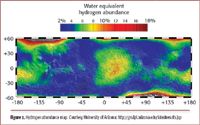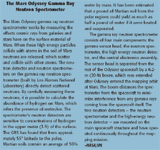Mars Express Finds Evidence of Liquid Water on Mars
Since the discovery of gullies on Mars in 2000, NASA has endeavored to re-image areas known to have them. Now for the first time, using before and after images taken of the same region on Mars, a dune gully flow is shown to have happened very recently.

On September 20, 2005, NASA held a media teleconference addressing recent changes on Mars that have been observed with the Mars Global Surveyor spacecraft, which has been orbiting Mars successfully since 1997. Among the highlights of the teleconference were before and after images shown of rock falls, a new impact crater, a receding south polar region, and a sand dune that appears to have recently formed gullies running from its crest to its base, suggesting fluid flow. Finding gullies on Mars is nothing new, thousands of them have been found to date, lining the sun-facing walls of impact craters and sand dunes located at latitudes poleward of 30°. First reported by Malin and Edgett in 2000, they published that the gullies were evidence of ground-water seepage from dust-mantled snowpacks on Mars but that they could not tell if the gullies themselves were recent or thousands to millions of years old.
In 2001, the gamma-ray spectrometer on board NASA's Mars Odyssey orbiter detected large quantities of hydrogen emanating from just under the surface of Mars in almost every location it searched. Planetary scientists believe that a planet-wide permafrost layer exists in various quantities beneath the dry surface.

Figure 1. MGS image showing (in color) numerous frosted gullies that mantle the slopes of a crater in Noachis Terra near 50.18S, 356.48W. Malin in 2000 suggested the gullies formed by the down slope movement of liquid water mixed with debris in the geologically recent Martian past. Olivier de Goursac, a space imaging specialist who has worked with NASA/JPL's Mars mission scientists since the Viking mission of the 1980s created this colorized view. Courtesy NASA/JPL/MSSS, Images "Visions of Mars" (Abrams Publishing) by Olivier de Goursac.
Since the discovery of gullies in 2000, NASA had initiated a program using Mars Global Surveyor to re-image areas known to have them. Now for the first time, using before and after images taken of the same region on Mars, a dune gully flow is shown to have happened very recently. On July 17, 2002, in an unnamed crater west of the Hellas impact basin, a dune field was imaged and then re-imaged on April 27, 2005. The 2002 image shows an undisturbed sand dune and in the 2005 image, the same sand dune has a series of gullies meandering through it. Was this the first evidence for running liquid water on Mars? John Mustard, associate professor of geology at Brown University in Providence, Rhode Island, was one of the NASA teleconference panelists and says, "The first image was taken in the season of southern hemisphere fall. It is about the middle of that season, and not yet cold enough for frosts to form. The second was taken about the middle of southern spring. So we cannot on the basis of these observations pinpoint the exact timing of the event, only that it occurred between these observations." Mustard pointed out that the location of dune is about 50° south and would have been below the frost point of water and carbon dioxide during the winter. During the winter, many Martian dunes have frost coverings on them that disappear in spring. So far, only winter surface temperature readings have been available from the thermal emission spectrometers on the Mars Global Surveyor and Mars Odyssey spacecraft.
Water Fluidization or Carbon Dioxide Sublimation?
Mike Malin, principal investigator for the Mars Global Surveyor camera, in contrast to his 2000 theory of groundwater-seepage in crater gullies, told media attending the conference that he feels the dune gullies might be caused by frozen carbon dioxide that becomes incorporated into the sand dunes during the winter. Malin went on to say that as sunlight would warm the dunes in the spring, that any frozen carbon dioxide trapped in them would turn to gas and where it would sublimate through the sand pores causing it to flow like an avalanche.

Figure 2. Hydrogen abundance map. Courtesy University of Arizona: http://grs.lpl.arizona.edu/latestresults.jsp
Not everyone agrees with Malin's hypothesis. Mary Bourke, a research scientist for the Planetary Science Institute in Tucson, Arizona, is a geomorphologist whose expertise is sand dunes. At a September 5 meeting for the British Association for the Advancement of Science held at Trinity College, Dublin, Ireland, she presented evidence for water fluidization as the cause of the gullies in the Kaiser sand dune field on Mars. Using terrestrial debris flows as an analogy, Bourke's interpretation of the Martian dune gullies is that melt water at the near-surface of the dune causes a decrease in the critical strength to produce a sufficient amount of sand to slip, which then triggers a debris flow. "What my research has done is to take the observations of induration in the sand dunes and couple this with the observations of flow features on the dunes to put forward an hypothesis that snow and ice could be the responsible volatile." Bourke is well aware there might be several triggering mechanisms for dune gully formation on Mars including carbon dioxide sublimation. "The idea of CO2 as an geomorphologically important volatile was previously stated by Hoffmann (2000). There is also the hypothesis that these features are produced by dry grain flows," she said. Dry grain flows on Mars have been observed by the European Space Agency's Mars Express Orbiter, which in some images clearly show wind-blown sand being blown down into craters and dunes. Over time, gullies could form. Although Bourke still is confident that her hypothesis of melt-water is the primary cause of the Martian dune gullies, she says, "It is good science to keep an open mind about all of these."
Bourke also worked on the dune gully problem with Hidaeki Miyamoto, a geomorphologist with the Department of Geosystem Engineering at the University of Tokyo, Japan. Using data from the Mars Global Surveyor Thermal Imaging Spectrometer, they concluded that the Martian dune gullies in the areas they studied were explained easier by water-related phenomena than by the slip-faulting of sand produced by CO2 gas.

Figure 3. Overlay of water equivalent hydrogen abundances and a shade relief map derived from MOLA topography. Mass percents of water were determined from epithermal neutron counting rates using the neutron spectrometer aboard Mars Odyssey between February 2002 and April 2003. Courtesy Los Alamos National Laboratory.
An upcoming paper to be published in the AGU journal Geophysical Research Letters will show that University of Arkansas laboratory simulations under Martian conditions show that liquid water can exist today. It has been found that mineral salts common on Mars can extend the temperature range over which liquid water is stable to –40 °C. The findings indicate that liquid water could exist on the Mars surface at different locations and times of day. This is an extremely important finding for the survival of any microbial life that might still exist. More information is available at: http://dailyheadlines.uark.edu/5717.htm.
In November of 2005, researchers for the European Space Agency's Mars Express orbiter's MARSIS (Mars Advanced Radar for Subsurface and Ionospheric Sounding) radar experiment announced that they might have found the first real liquid water on Mars — under its surface. MARSIS is designed to examine materials in the Martian interior using radar echoes. During the past summer, MARSIS received two strong echoes coming from a subsurface region near the Northern Polar Ice Cap that seemed to indicate an interaction of two different types of materials. After examining the MARSIS data, the science team reported that they might have found nearly pure liquid water mixed in a large water–ice layer, more than 1 km thick, that overlays a surface of basaltic soil.

The Mars Odyssey Gamma Ray Neutron Spectrometer
NASA's next surface mission, the 2007 Phoenix Lander, will examine in detail the surface soils for any signs of water and organic molecules. The landing site for Phoenix will be near to the Northern Polar Ice Cap.
Barry E. DiGregorio is a research associate for the Cardiff Centre for Astrobiology (Cardiff, Wales, U.K.).

High-Speed Laser MS for Precise, Prep-Free Environmental Particle Tracking
April 21st 2025Scientists at Oak Ridge National Laboratory have demonstrated that a fast, laser-based mass spectrometry method—LA-ICP-TOF-MS—can accurately detect and identify airborne environmental particles, including toxic metal particles like ruthenium, without the need for complex sample preparation. The work offers a breakthrough in rapid, high-resolution analysis of environmental pollutants.
The Fundamental Role of Advanced Hyphenated Techniques in Lithium-Ion Battery Research
December 4th 2024Spectroscopy spoke with Uwe Karst, a full professor at the University of Münster in the Institute of Inorganic and Analytical Chemistry, to discuss his research on hyphenated analytical techniques in battery research.
Mass Spectrometry for Forensic Analysis: An Interview with Glen Jackson
November 27th 2024As part of “The Future of Forensic Analysis” content series, Spectroscopy sat down with Glen P. Jackson of West Virginia University to talk about the historical development of mass spectrometry in forensic analysis.
Detecting Cancer Biomarkers in Canines: An Interview with Landulfo Silveira Jr.
November 5th 2024Spectroscopy sat down with Landulfo Silveira Jr. of Universidade Anhembi Morumbi-UAM and Center for Innovation, Technology and Education-CITÉ (São Paulo, Brazil) to talk about his team’s latest research using Raman spectroscopy to detect biomarkers of cancer in canine sera.